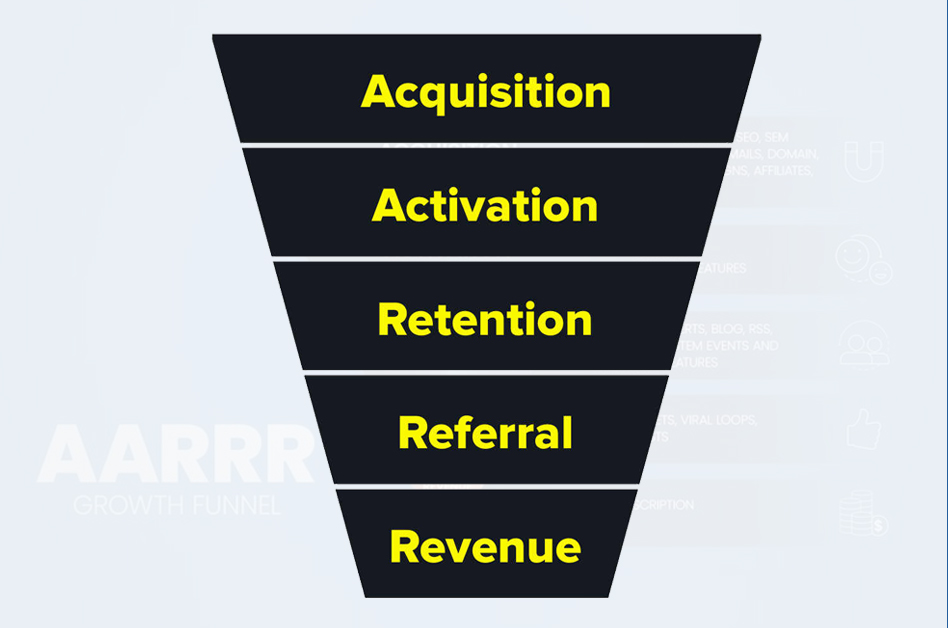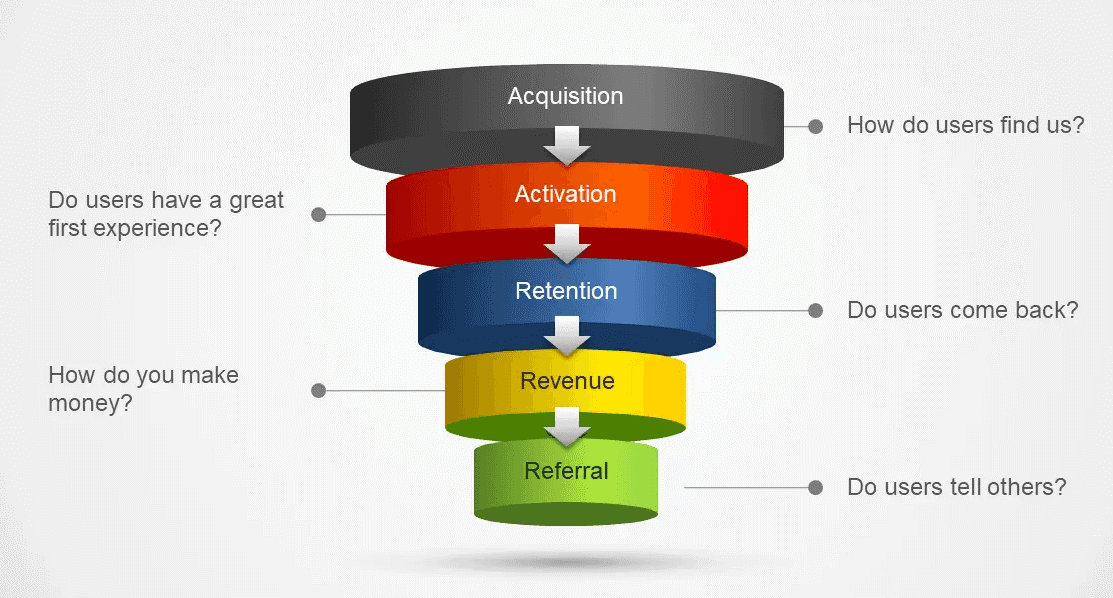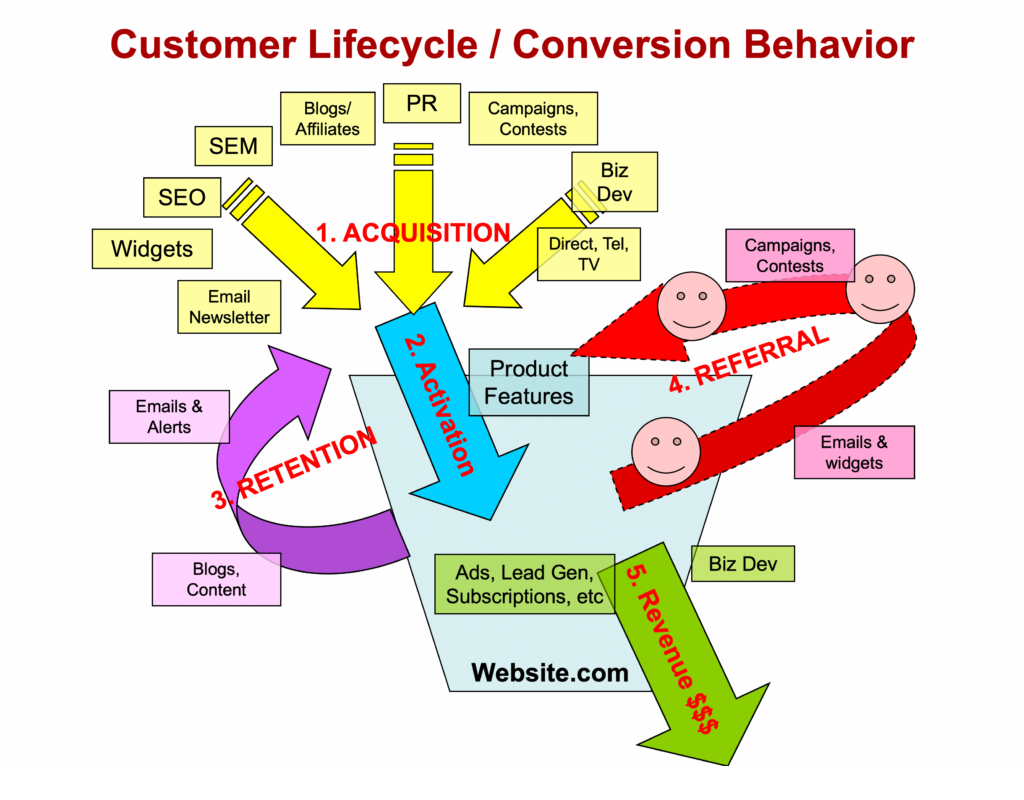
AARRR is a growth model derived from the acronym of 5 main stages in a basic customer journey including: Acquisition, Activation, Retention, Referral, and Revenue
AARRR in the form of a funnel tends to gradually narrow in subsequent stages, from top to bottom. This also means that as users progress through each stage of the funnel, the conversion rate will gradually decrease
Description of AARRR stages
- Acquisition: Where do users come from? How to attract users?
- Activation: How to turn attracted users into users who actually use the product?
- Retention: How to make users come back?
- Referral: How can users introduce translated products to others?
- Revenue: How to bring in the most revenue per user?

Specific analysis of each stage in the AARRR model
Acquisition:
The goal in the Acquisition phase is to focus on how to attract and reach potential users or customers. This is also an important step in building an initial customer base and creating brand awareness
To attract users in the Acquisition phase, two important factors need to be identified
- Target customer: It is necessary to clearly define the portrait of the customer including demographic characteristics such as age, gender, location..., psychological characteristics, behavior and needs. , their pain point
- Effective Marketing channels and strategies to reach target customers: At least 15 different Marketing channels can be used to attract new customers, including popular channels such as: Online advertising (Google Ads , Facebook Ads…..), SEO, Content Marketing (blog, video), Social Media (Facebook, Instagram, Tiktok….), Email Marketing, Community, PR, OOH…..
- Customer acquisition cost (CAC): The cost to attract a new customer or new user.
- Conversion rate: Conversion rate from traffic source to generated Lead/customer/user.
- New users/New leads/New customers: Depending on the business model, the output that needs attention is the number of new users, the number of new customers, or the number of new leads.
Activation:
The goal of the Activation phase is to motivate new users to become real Active users through performing those important actions
To be active, the true core values of your product or service must be felt by new users. Therefore, the product’s Aha moment needs to be determined to help users create a deep connection with the product, realize real value and tend to use it for a long time. This is not just a temporary experience, but can influence future attitudes and behavior, promoting continued use and taking full advantage of the product’s benefits
Metrics in the Activation phase include:
- Activation rate: Measures the percentage of users acquired at the Acquisition stage who take activation actions.
- Activation time: Measure the time from reaching a user until they activate the product or service.
- Aha moment: Number of users experiencing an Aha moment. The time of the Aha moment may be different from the time of the trigger action
Retention:
The main goal of the Retention stage is to ensure customers continue to use the product or service regularly, thereby increasing customer lifetime value (CLV) during the Revenue stage.
To achieve a high Retention rate and retain users long-term, the key to success is to help users start to form a habit of using the product regularly, such as daily, weekly, or daily. or monthly depending on the nature of the product or service. Maintenance motivation will come from within them, motivating them to continue using the product voluntarily without external encouragement
Metrics in the Retention phase include:
- Retention Rate: The rate of users who continue to return to use the product within a certain period of time. You can track retention after 1 day, 7 days, 30 days, or other timelines to better understand user engagement.
- Churn Rate: The rate of users who stop using your product for a certain period of time. Churn Rate is the opposite of Retention Rate. The lower the churn rate, the higher the retention rate.
- Frequency: Measure the frequency of how many times users use your product or service in a certain period of time. This index shows user engagement and habits
Referral:
The goal of the Referral Stage is to encourage existing users to recommend their product or service to others. When users refer friends or relatives, businesses have the opportunity to reach new potential customers through the trust and appreciation of existing users at a very low cost
To be successful in the Referral stage, the product or service must provide an excellent user experience. This is demonstrated by the percentage of users who maintain, stick with, love, support the product and are most likely to recommend it to others. To pay attention to the following important aspects
- Attractive rewards: Provide attractive rewards for both referrers and referred people. The reward should be large enough to motivate users to participate in the Referral program.
- Easy to share: Make it easy for users to share your product or service with others through social media channels, email, or easy-to-use referral links.
- Clear and transparent process: Ensure that the onboarding and rewards process is clear and understandable and transparent to build trust. Users need to know exactly what they need to do and the rewards they will receive
- Number of referrals: Measures the number of new users that come from referrals from existing users.
- Referral rate: Measures the rate of current customers who engage in referral behavior.
- Net Promoter Score (NPS): Measures current customers' willingness to recommend through surveys
Revenue:
The goal in the Revenue Phase is to maximize revenue from existing users by motivating them to take revenue-generating actions, converting user engagement and engagement into revenue through different methods
Optimize Customer Lifetime Value, increase value from existing customers by applying upsell and cross-sell strategies, create customer loyalty programs, introduce additional or more premium products and services to increase revenue
Metrics in the Revenue phase include:
- Conversion Rate: This is the percentage of users who take revenue-generating actions, such as making a purchase, signing up for a service, or making a payment. A high conversion rate shows effectiveness in converting users into paying customers.
- Average order value (AOV – Average Order Value): This is the average value of an order. This metric helps you understand the average spend per transaction and can adjust your pricing and promotion strategy to maximize order value.
- Customer lifetime value (LTV - Lifetime Value): This is the total value that a customer brings to a business during the time they use a product or service. High LTV shows customer engagement and spending with the business




